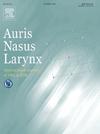Ultrasonography of the cricoarytenoid joint and its movements
IF 1.6
4区 医学
Q2 OTORHINOLARYNGOLOGY
引用次数: 0
Abstract
Objective
Ultrasound provides real-time anatomical information and motion. We used ultrasound to image the cricoarytenoid joint and its rotating, rocking, and gliding movements.
Methods
Between March and October 2023, 20 patients (10 males and 10 females) who visited our hospital underwent laryngeal ultrasonography. The joint cavity was delineated in four patients (20 %, two males and two females). Conversely, the other patients did not detect it because of acoustic shadows on ultrasonography. We also performed ultrasonography on five volunteers (three males and two females), but only two of them (two females) showed imaging of the joint cavity. Herein, we report the case of a female volunteer in her 30 s who had the best delineation of joint movements.
Results
Joint movements were three-dimensional, whereas ultrasound images were two-dimensional. However, combined with scanning techniques, characteristic joint movements were successfully imaged using ultrasound. Initially, we performed a trans-thyroid cartilage transversal procedure to visualize the muscular process of the arytenoid cartilage and rotational movement. Subsequently, the probe was rotated to an oblique position, and the articular cavity of the cricoarytenoid joint was visualized. We then observed the rocking and gliding movements. In Addition, we demonstrated a seamless transition from gliding to rocking. Finally, we observed that the arytenoid cartilage was pulled toward the posterior cricoarytenoid muscle (PCA) during sniffing. The PCA is the only muscle opening the vocal cords, so the arytenoid cartilage shifts toward the PCA and tilts outward from the larynx.
Conclusion
The presented probe scanning techniques and specific joint movements may help identify notable conditions such as arthritis or joint dislocation.
环杓关节及其运动的超声波检查
目的 超声波可提供实时解剖信息和运动信息。方法 2023 年 3 月至 10 月间,20 名就诊于我院的患者(10 男 10 女)接受了喉部超声检查。四名患者(20%,两男两女)的关节腔被划定。相反,其他患者则因超声波检查出现声影而未发现关节腔。我们还对五名志愿者(三男两女)进行了超声波检查,但其中只有两人(两名女性)显示出关节腔的影像。结果 关节运动是三维的,而超声波图像是二维的。然而,结合扫描技术,我们成功地利用超声波对关节运动特征进行了成像。首先,我们进行了经甲状软骨横向手术,以观察杓状软骨的肌肉过程和旋转运动。随后,探头旋转至斜位,环状蝶骨关节的关节腔被显现出来。然后,我们观察了摇摆和滑动运动。此外,我们还演示了从滑行到摇摆的无缝过渡。最后,我们观察到杓状软骨在嗅闻过程中被拉向环状蝶骨后肌(PCA)。PCA 是打开声带的唯一肌肉,因此杓状软骨会向 PCA 方向移动,并从喉部向外倾斜。
本文章由计算机程序翻译,如有差异,请以英文原文为准。
求助全文
约1分钟内获得全文
求助全文
来源期刊

Auris Nasus Larynx
医学-耳鼻喉科学
CiteScore
3.40
自引率
5.90%
发文量
169
审稿时长
30 days
期刊介绍:
The international journal Auris Nasus Larynx provides the opportunity for rapid, carefully reviewed publications concerning the fundamental and clinical aspects of otorhinolaryngology and related fields. This includes otology, neurotology, bronchoesophagology, laryngology, rhinology, allergology, head and neck medicine and oncologic surgery, maxillofacial and plastic surgery, audiology, speech science.
Original papers, short communications and original case reports can be submitted. Reviews on recent developments are invited regularly and Letters to the Editor commenting on papers or any aspect of Auris Nasus Larynx are welcomed.
Founded in 1973 and previously published by the Society for Promotion of International Otorhinolaryngology, the journal is now the official English-language journal of the Oto-Rhino-Laryngological Society of Japan, Inc. The aim of its new international Editorial Board is to make Auris Nasus Larynx an international forum for high quality research and clinical sciences.
 求助内容:
求助内容: 应助结果提醒方式:
应助结果提醒方式:


